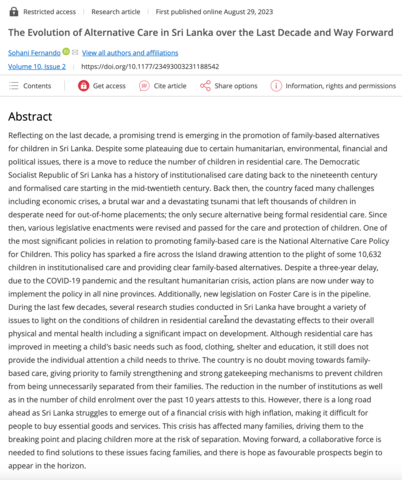Abstract:
Reflecting on the last decade, a promising trend is emerging in the promotion of family-based alternatives for children in Sri Lanka. Despite some plateauing due to certain humanitarian, environmental, financial and political issues, there is a move to reduce the number of children in residential care. The Democratic Socialist Republic of Sri Lanka has a history of institutionalised care dating back to the nineteenth century and formalised care starting in the mid-twentieth century. Back then, the country faced many challenges including economic crises, a brutal war and a devastating tsunami that left thousands of children in desperate need for out-of-home placements; the only secure alternative being formal residential care. Since then, various legislative enactments were revised and passed for the care and protection of children. One of the most significant policies in relation to promoting family-based care is the National Alternative Care Policy for Children. This policy has sparked a fire across the Island drawing attention to the plight of some 10,632 children in institutionalised care and providing clear family-based alternatives.
Despite a three-year delay, due to the COVID-19 pandemic and the resultant humanitarian crisis, action plans are now under way to implement the policy in all nine provinces. Additionally, new legislation on Foster Care is in the pipeline. During the last few decades, several research studies conducted in Sri Lanka have brought a variety of issues to light on the conditions of children in residential care and the devastating effects to their overall physical and mental health including a significant impact on development. Although residential care has improved in meeting a child’s basic needs such as food, clothing, shelter and education, it still does not provide the individual attention a child needs to thrive. The country is no doubt moving towards family-based care, giving priority to family strengthening and strong gatekeeping mechanisms to prevent children from being unnecessarily separated from their families. The reduction in the number of institutions as well as in the number of child enrolment over the past 10 years attests to this.
However, there is a long road ahead as Sri Lanka struggles to emerge out of a financial crisis with high inflation, making it difficult for people to buy essential goods and services. This crisis has affected many families, driving them to the breaking point and placing children more at the risk of separation. Moving forward, a collaborative force is needed to find solutions to these issues facing families, and there is hope as favourable prospects begin to appear in the horizon.

